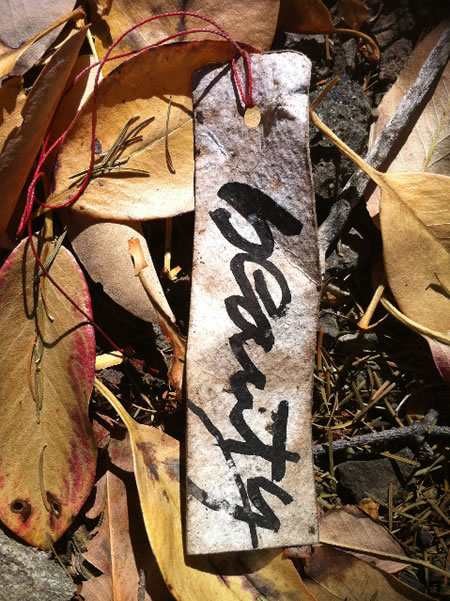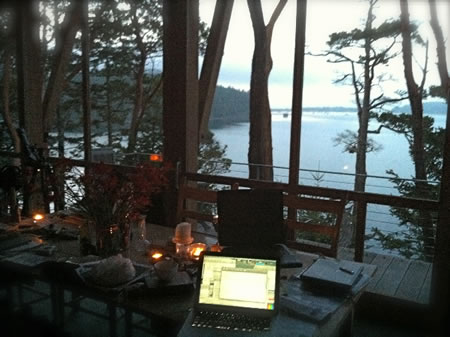Seeking beauty, active focus, and contemplative strategy in remote locations: working someplace other than where you’re supposed to be.

Found in the dirt, as a reminder of something special, recalled in a remote place of work.
I’ve thought about — and practiced — the idea of working, roving, writing, designing, building strategy or tactical planning somewhere other than the office(s) downtown, or around people. Being with people is critical, being away from people is equally important. The verse of conversations are counterbalanced in the silence of directed attention.
Meditations on working remotely:
I love being around people, exploring ideas, sharing thinking and being in close connection with clients and colleagues. I’ll drive or fly hundreds of miles to do that. I’ll drive or fly hundreds of miles, as well, to get away from that.
THERE ARE ADVANTAGES. AND THERE ARE DISADVANTAGES.
1. The idea of doing something with, and around, people is important. It teaches you the manners and etiquette of being with people — and communicating with them. I find a surprising lack of skill among some, in this simple gesture of connection, presentation, meaningful organization of ideas — and the expression of them, live: eye to eye. There are huge advantages to connecting with people live: eye to eye. You can sense more to who they are — if you can truly see them. I’ve noted an increasing tendency among colleagues that sending an email or text is sufficient to assure connection. I get emails from employees, when I’m only a matter of feet away, rather than stopping by to ask a question or confirm an approach. I then see the email at 10.00pm that evening, and completely miss the question, the timing, and the answer. What that says is that it’s far better to be linking, quickly to comment, then to presume that electronic media will suffice. That is, when you’re there.
2. The idea of doing nothing with, and around, people is important.
To the concept of seeking organizational solitude, I find that days will pass in my attempts to write out complex strategy, written documents, for messaging, planning for complicated communications or interview and brand auditions. Finally, I will head out, take a brake, and seek the quiet of focused contemplation. I’m still linked in, everywhere, but I’m not surrounded by pressing issues that constantly distract my focus.

A fresh set of tools to work with, explore and dig into for differentiated explorations.
Returning to the notions of attention and intentional action, the idea of taking the time to be away, working remotely to the scene, allows for that sense of continuous attention to the multiplicity of actions that are tied to doing the work, to running a business (which can be like sprinting, it would appear — there are not a lot of respites) as well as the centering tasks that need to be directed as part of the premise of refreshment. That presumes that you’re roving in a manner, or working remotely in a way that allows you to be a sentinel of what’s happening — where you are not present. There’s something, as well, to being remote — working remotely — and really not being connected at all. Work and be silent.
It’s been years since that’s happened to me — being remote, and completely without cognizance of what’s happening, at Girvin, with clients, relationships. I don’t see that as something that’s happening soon.

Making working place, special — ritual, beauty, ideas, objects, inspirations.
Some meditations on remote work:
• Contemplation, should be seen, in scene, in the context of the original etymon of the word: “with temple” — from the Latin, con + templum. Think of your remote work as special — something sacred, to be cherished and held as an embraceable ideal.
• Create a special place for your remote work. If you must work away — or have the special chance to do that — create a special way in which that character can be savored. Remote work shouldn’t be irksome, but perhaps even more pleasurable.
• Think of the remote mind. Considering the original meaning of the word, remotus, from the Latin, seen and heard in the 15th century — it was about being “removed” — to move back, and away, from something. That remote viewing allows you to be seeing, and thinking, about problems in a way that’s distant. I call this walking around a problem — in the manner of circumambulation — you’re seeing it from varying perspectives.
• Bracket time for silence: sometimes, to remoteness, it’s all the more reason for everyone to want to talk to you. Be quiet, retreat in silence. You can always think better when your mouth isn’t working.

My remote studio, 80 miles from Seattle, the San Juan Archipelago, Decatur Island
Sometimes being the warrior of the way, being incessantly on the road, you must be the remote sentinel perpetually. Standing in airports, seeking a plug location for power, I listen to people simply trying to make connections — even frantically: they’re trying to get home, metaphorically. They’re trying to find a home where they can be. As a worker — in the space of intentional knowledge — your home will be where your heart is; that’s where the best thinking will percolate — and others will benefit in the rippling of your refreshed ideas.
Remove yourself from the fray, and perhaps you might see better.
Tim
–––
B U I L D I N G L O V E B R A N D S
the reels: http://www.youtube.com/user/GIRVIN888
girvin blogs:
http://blog.girvin.com/
https://tim.girvin.com/index.php
girvin profiles and communities:
TED: http://www.ted.com/index.php/profiles/view/id/825
Behance: http://www.behance.net/GIRVIN-Branding
Flickr: http://www.flickr.com/photos/tgirvin/
Google: http://www.google.com/profiles/timgirvin
LinkedIn: http://www.linkedin.com/in/timgirvin
Facebook: http://www.facebook.com/people/Tim-Girvin/644114347
Facebook Page: http://www.facebook.com/pages/Seattle-WA/GIRVIN/91069489624
Twitter: http://twitter.com/tgirvin